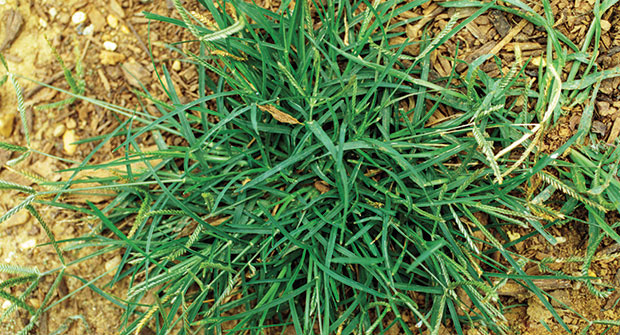While some may think of crabgrass and goosegrass synonymously, keeping in mind a few key differences may help formulate an effective plan of attack against each weed.
Lawn care operators (LCOs) Brian Haga, president of Scientific Plant Services in Baltimore, Md., and Luke Henry, founder and president of ProScape Lawn & Landscape Services in Marion, Ohio, share their knowledge of crabgrass and goosegrass.

The differences
To tell crabgrass and goosegrass apart Henry suggests looking at the center of the plant.
“If I see a whitish ‘wagon-wheel’ appearance with the stems against the ground, that tells me it is goosegrass,” he says.
Additionally, while many varieties of crabgrass feature a hair leaf sheath and can grow up to 3 feet tall, goosegrass, on the other hand, shows more of a rosette growth habit and can be as wide as 6-8 inches.
It’s also important to keep in mind that goosegrass germinates later in the season than crabgrass, sometimes by about three to four weeks.
“Goosegrass can sometimes cause issues by sprouting after preemergent herbicides have broken down,” Henry says.
Crabgrass typically germinates when soil temperatures are sustained above 55 degrees F, and goosegrass usually develops when soil temperatures at a 4-inch depth are around 60-65 degrees F.
The similarities
Both annual grassy weeds, crabgrass and goosegrass feature fuzzy, finger-looking characteristics near the top, look brushy and thrive in areas with thin soil, such as near driveways, sidewalks and mailboxes, according to Henry.
“Lots of times, they come in where grass is being mowed too short or if grass is in bad shape from foot traffic or pets,” Haga says. “It makes it easier for those plants to flourish because the fescues and the bluegrasses naturally slow down and go dormant in those areas because of stress.”
Because of the similarities, cultural and preemergent practices look much the same for both weeds.
“Prevention is the same for cool-season lawns: a thick lawn, mowed at 3 inches with aerated (not compacted) soil,” Haga says.
Henry adds that proper fertilization and overseeding with a quality tall fescue variety will help further thicken out the lawn and keep weeds out.
For chemical control, Haga says Scientific Plant Services’ technicians apply one application of preemergent herbicide in the late fall or early spring with the active ingredient of prodiamine or dithiopyr.
Henry adds that ProScape’s technicians are careful to be particularly thorough with the springtime preemergent application around corners and edges.
Haga acknowledges that postemergent control is more difficult, but multiple applications of an herbicide with the active ingredient of topramezone will usually get the job done.
ProScape’s crews use an herbicide with quinclorac to target the weeds postemergently. However, Henry says if the infestation isn’t widespread, technicians can resort to pulling the plant out, especially later in the season.
“It doesn’t really root deeply so somebody can just grab it and pull it out if there’s just a spot here or there in a bed,” he says.


